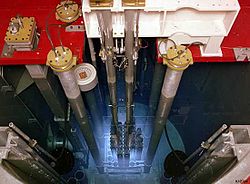Beta particle
Beta particles are electrons or positrons emitted by some radioactive nuclei such as potassium-40 or carbon-14 (which becomes nitrogen-14).[1] The beta particles emitted are a form of ionizing radiation sometimes called beta rays. Henri Becquerel and Ernest Rutherford discovered beta rays in the 1890s. Beta particles are made by beta decay. When scientists write it in an equation, they are use the Greek letter beta (β). There are two forms of beta decay, β- and β+, which make the electron and the positron. β- is a single electron that has a negative charge of -1. Both beta decays also turn a neutron into a proton.
Beta Particle Media
Alpha radiation consists of helium nuclei and is readily stopped by a sheet of paper. Beta radiation, consisting of electrons or positrons, is stopped by a thin aluminium plate, but gamma radiation requires shielding by dense material such as lead or concrete.
Beta decay. A beta particle (in this case a negative electron) is shown being emitted by a nucleus. An antineutrino (not shown) is always emitted along with an electron. Insert: in the decay of a free neutron, a proton, an electron (negative beta ray), and an electron antineutrino are produced.
Blue Cherenkov radiation light being emitted from a TRIGA reactor pool is due to high-speed beta particles traveling faster than the speed of light (phase velocity) in water (which is 75% of the speed of light in vacuum).
Beta radiation detected in an isopropanol cloud chamber (after insertion of an artificial source strontium-90)
References
- ↑ Lawrence Berkeley National Laboratory (9 August 2000). "Beta Decay". Nuclear Wall Chart. United States Department of Energy. Archived from the original on 3 March 2016. Retrieved 17 January 2016.




